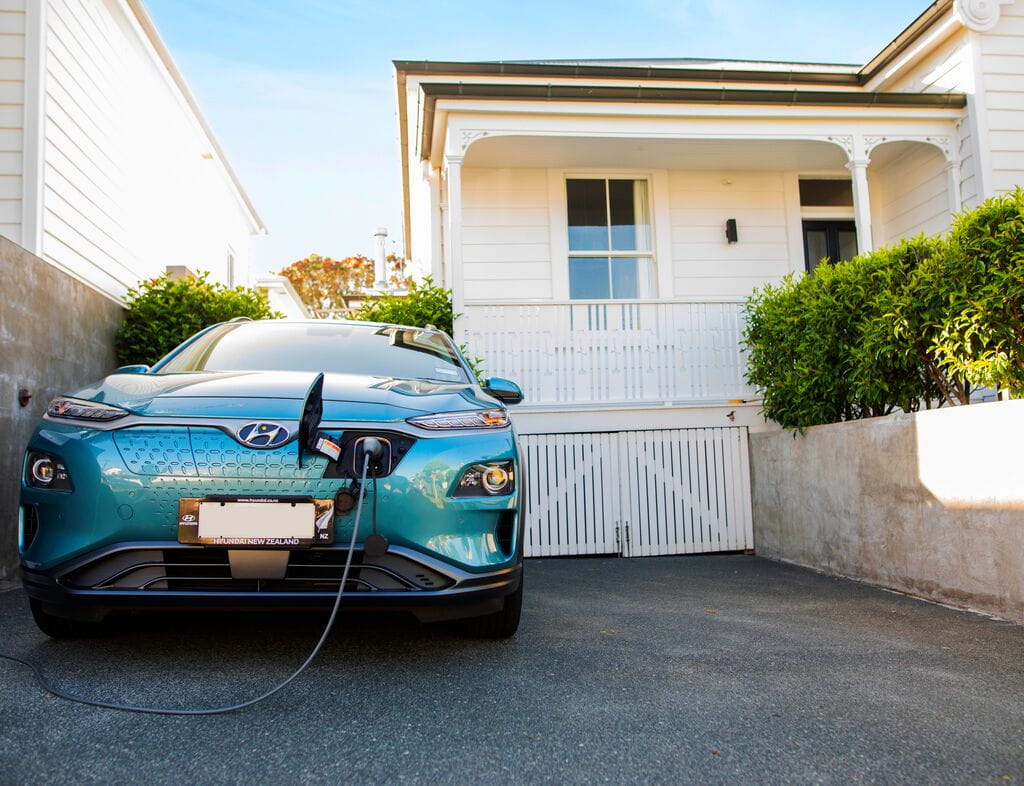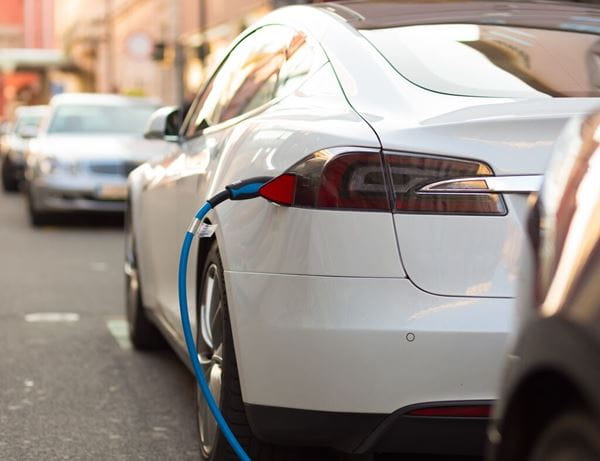
Getting Started: An Introduction to Home Electric Vehicle Charging
The convenience of home charging is one of the biggest perks of driving an electric car, and installing one is easier than it seems. Here’s what you need to know.
Why is it worth getting a charging point at home?
Most electric vehicles are charged at home [1] – it’s where they’re parked for the longest and means you can wake up to a full battery every morning if they need it. Although you can charge from a domestic plug socket, upgrading to a wallbox provides several benefits:
- Up to three times faster charging speeds
- Weatherproof connections making it safer to plug in
- There’s no need to trail cables through windows or under garage doors
- Track energy usage and schedule charging when energy is cheapest
Charging from a domestic socket is increasingly rare. Most new plug-in hybrid and electric cars are supplied with a cable for use with dedicated chargepoints – either at home, work or on the road. Cables with a three-pin plug are often a cost option, designed as a backup, and are not compatible with the majority of public charging points.
Can I claim funding towards a home charging point?
It depends on your circumstances. The government’s Office for Zero Emission Vehicles (OZEV) has provided grants for installing home electric vehicle chargers since 2013 [2]. Funding has reduced in the meantime, but the latest Electric Vehicle Chargepoint Grant provides up to 75% towards equipment and installation costs, capped at £350 [3].
Grants are available to people living in flats and rented accommodation who own, lease or are the primary user (e.g. a company car driver) of a qualifying plug-in hybrid or electric vehicle.
Most homeowners in single-unit properties (a house or bungalow) no longer qualify, and the grant can’t be used to upgrade existing charging points, even if they are incompatible with the driver’s current vehicle.
Since March 2024, drivers in properties (either rented or owned) without their own parking space can also claim the grant [4]. It’s an important addition, because roughly a quarter of all vehicles in England are stored on-street overnight, according to the latest Department for Transport data [5].
Do I need planning permission to install an EV charging point?
Installations on private property are classed as permitted development [6, 7, 8], so there’s no need for planning permission unless they are…
- ...being installed on a listed building or monument
- …located in a conservation area
- ...facing onto and within two metres of a public highway
The parking space doesn’t have to be attached to your home (for example, if you live in a flat) but it can’t be shared with other households or require cables to be run across public land – such as a pavement or footpath.
On-street charging points are a little more challenging. You’ll need permission from local planning and highways authorities and measures to avoid trip hazards if you’re running cables across a pavement before installation can begin. OZEV also makes it clear that a charging point doesn’t reserve the adjacent space for your use – so you might not always have somewhere to plug in overnight.
How do I choose the right EV charging point?
There are hundreds of models available in the UK, but choosing an appropriate electric car charger for your home isn’t as complicated as it sounds. Here’s what you need to consider:
How fast do you want to charge?
Most domestic EV chargers offer a maximum output of:
- 3.7kW (16-amp) – restoring around 15 miles per hour plugged in.
- 7.4kW (32-amp) – restoring about 30 miles per hour plugged in.
As a rule of thumb, vehicles with a range of more than 200 miles would need a 7.4kW wallbox to get a full charge overnight. Lots of suppliers don’t offer anything slower than that anyway [9].
Properties with a three-phase supply can claim OZEV funding for a 22kW charger, but only a handful of vehicles charge at more than 11kW from an AC electricity supply. Higher-powered DC chargers are significantly more expensive to buy and install and typically only found at depots and on public networks.
Do you want a tethered lead, or a socket?
Compatibility issues are a myth. The Type 2 connector was standardised in Europe a decade ago [9], and it’s now used by most AC charging points and all new electric and plug-in hybrid vehicles sold in Europe – including Teslas.
At home, you’ve got a choice. Some charging points have a Type 2 socket compatible with the cable supplied with the majority of cars and vans – a bit like a USB port charging different portable devices. Others feature a built-in cable and connector that matches the socket on the vehicle. It’s easier than unravelling a cable from the boot, but might be incompatible with some older cars and vans.
What data-connected features do you need?
Built-in data connections became mandatory for grant-funded chargepoints in July 2019 [10]. Since June 2022, this requirement was extended to all home chargepoints regardless of whether they are grant funded or not [11].
The latest units offer:
- Over-the-air updates and maintenance
- Charge scheduling, and the ability to track and report energy usage, often via an app, which is useful for reimbursement
- Software enabling utility companies to pause, slow or defer charging sessions during peak periods or based on cost – but only if drivers opt in
New ‘smart chargers’ will be supplied pre-set to operate outside peak hours (8-11am and 4-10pm on weekdays), but drivers must be able to override any delays and begin charge sessions immediately if they need to. That choice is always yours.
What does installing an electric car charging point at home involve?
Installing a home electric car charging station will be undertaken by approved contractors. It’s a routine job that typically takes less than a couple of hours.
Similar to an electric oven, the units are hard-wired into the household’s 230-volt supply and – aside from old properties that haven’t had recent upgrades – there should be no need for additional work. Installers will carry out a survey beforehand and apply to the electricity DNO (Distribution Network Operator) for permission to install. They can also apply for the grant on your behalf.
Easier still, ALD | LeasePlan enables drivers to add a domestic charge point during the vehicle ordering process, either as part of the monthly costs or paid for up front. This provides either a tethered or socketed 7.4kW wallbox, fully installed and accompanied by a three-year warranty and 24/7 support, and you will own it at the end of the contract. It’s a convenient way to get the right start for your electric journey.
REFERENCES:
[1] Department for Transport (2022) Electric Vehicle Charging Research Survey with electric vehicle drivers. [online] Available at: https://assets.publishing.service.gov.uk/media/628f5603d3bf7f037097bd73/dft-ev-driver-survey-summary-report.pdf. [Accessed 17 May 2024].
[2] Office for Low Emission Vehicles. (2018). [Withdrawn] Grant scheme for the installation of plug-in vehicle chargepoints on the UK government and wider public sector estate. [online] Available at: https://www.gov.uk/government/publications/grant-scheme-for-the-installation-of-plug-in-vehicle-chargepoints-on-the-uk-government-and-wider-public-sector-estate [Accessed 17 May 2024].
[3] UK Government. (n.d.). Electric vehicle chargepoint grant for renters and flat owners. [online] Available at: https://www.find-government-grants.service.gov.uk/grants/electric-vehicle-chargepoint-grant-for-renters-and-flat-owners-1. [Accessed 17 May 2024].
[4] UK Government. (n.d.). Electric Vehicle Chargepoint Grant for Households with On-Street Parking [online] Available at: https://find-government-grants.service.gov.uk/grants/electric-vehicle-chargepoint-grant-for-households-with-on-street-parking-1.[Accessed 17 May 2024].
[5] Department for Transport. (2024). NTS0908: Where vehicle parked overnight by rural-urban classification of residence: England, 2002 onwards. Available at: https://assets.publishing.service.gov.uk/media/64e8c64e691aa3000da56e46/nts0908.ods [Accessed 17 May 2024].
[6] Ministry of Housing, Communities & Local Government (2015) Town and Country Planning Act (General Permitted Development) (England) Order 2015 [Accessed 17 May 2024].
[7] Department for Communities and Local (2019) Town and Country Planning (General Permitted Development) (Amendment) (Wales) Order 2019 [Accessed 17 May 2024].
[8] Local Government and Communities Directorate (2014) The Town and Country Planning (General Permitted Development) (Scotland) Amendment Order 2014 [Accessed 17 May 2024].
[9] Mennekes (n.d.). EV charging cable. [online] Available at: https://www.mennekes.org/emobility/products/ev-charging-cable/ [Accessed 17 May 2024].
[10] Department for Transport (2019) Electric Vehicle Smart Charging. [online] Available at: https://assets.publishing.service.gov.uk/government/uploads/system/uploads/attachment_data/file/817107/electric-vehicle-smart-charging.pdf [Accessed 17 May 2024].
[11] Department for Transport (2021) The Electric Vehicles (Smart Charge Points) Regulations Impact Assessment. [online] Available at: https://assets.publishing.service.gov.uk/government/uploads/system/uploads/attachment_data/file/1015290/electric-vehicles-smart-charge-points-regulations-2021-impact-assessment.pdf [Accessed 17 May 2024].

.jpg?rev=3adbd558867c4d92bf9f22752f12a09c&mw=600)

